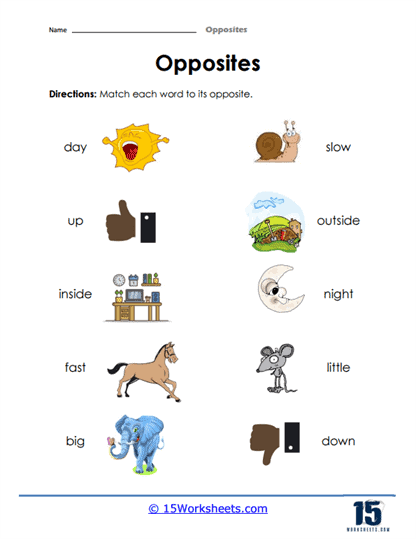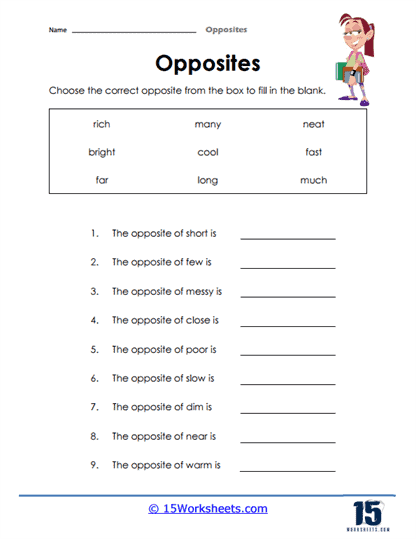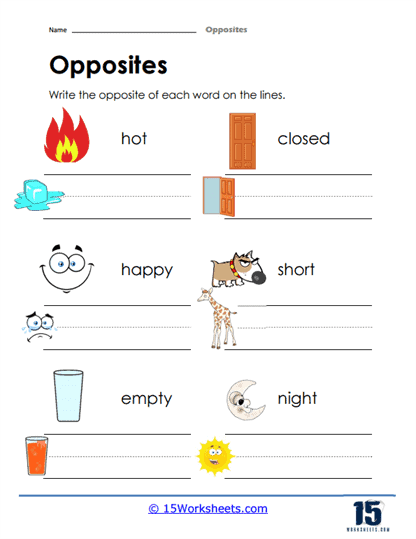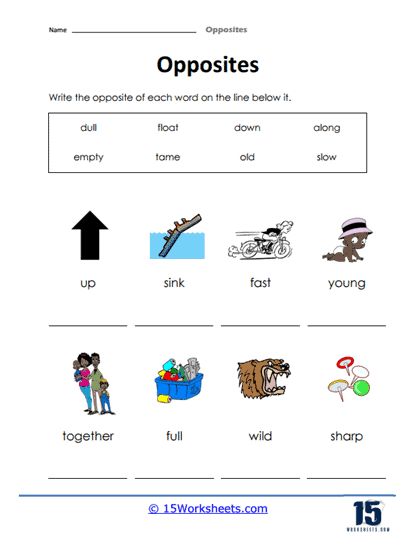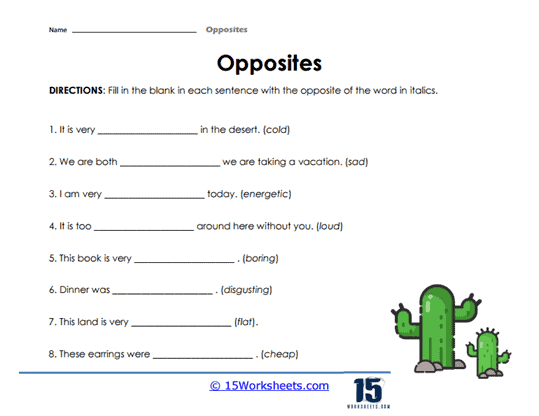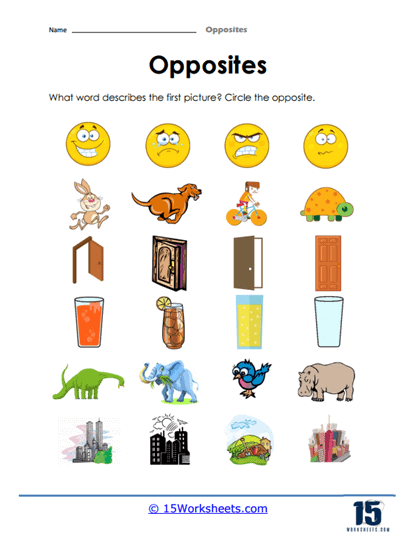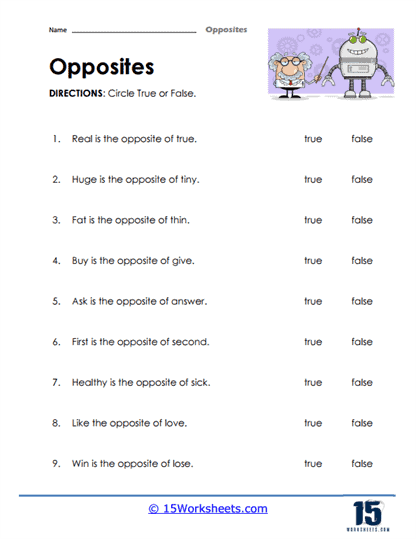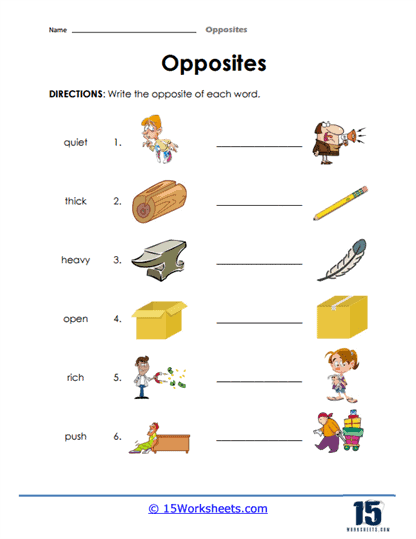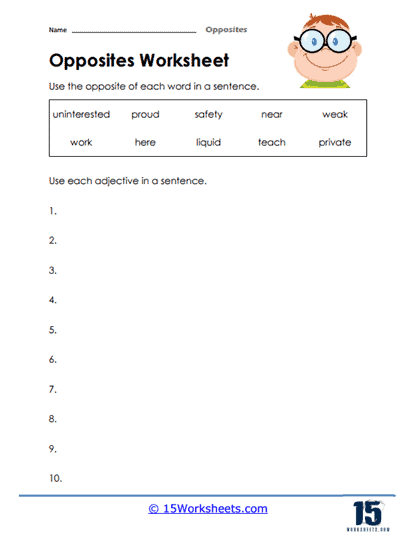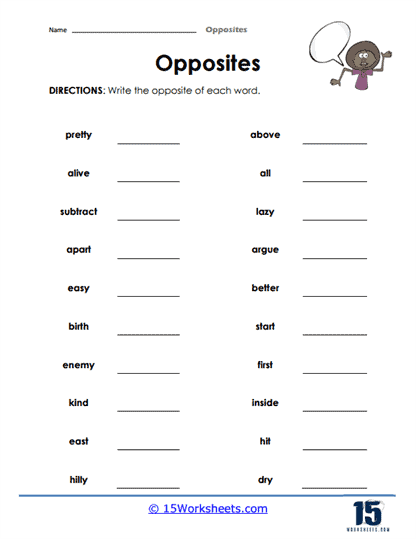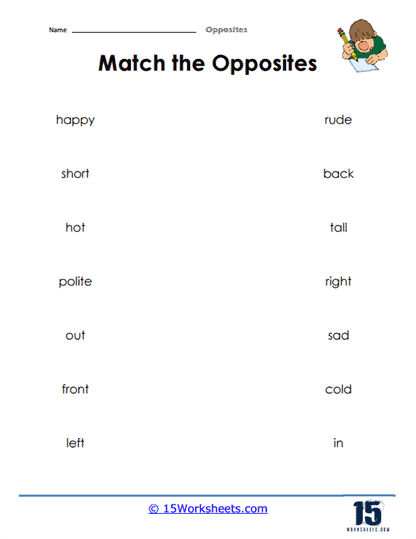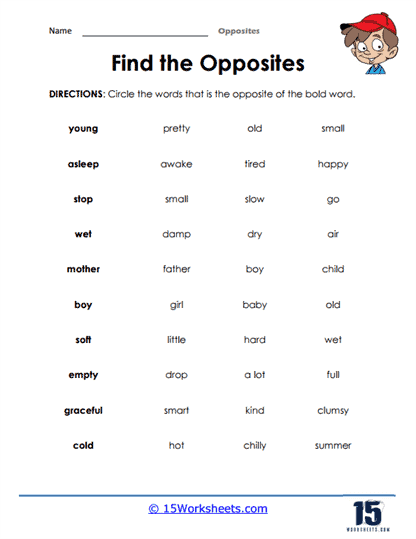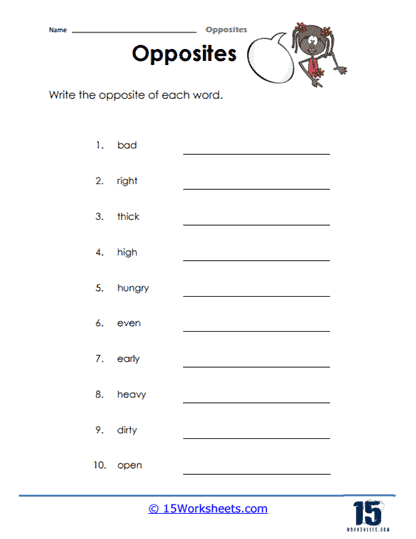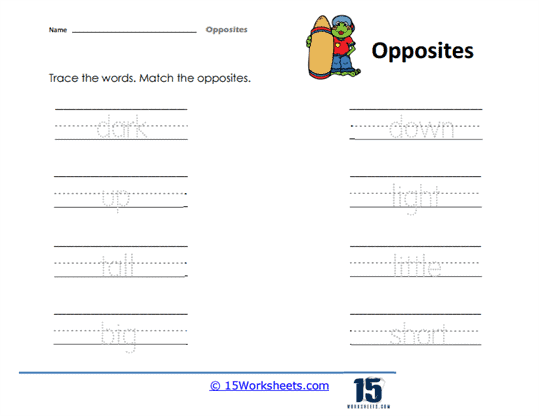Opposites Worksheets
All About These 15 Worksheets
Our opposite worksheet collection will help children understand the concept of opposites, or antonyms, by comparing words that have completely different meanings. These worksheets introduce children to pairs of words like “big” and “small,” “hot” and “cold,” or “happy” and “sad.” By helping children identify and understand these contrasting concepts, opposites worksheets play a critical role in expanding their vocabulary, improving their comprehension, and developing critical thinking skills. These worksheets are typically used in early education but are valuable for any learner who needs to reinforce their understanding of language fundamentals.
Understanding opposites is foundational to learning how language works because it helps children make sense of the world around them. By recognizing that things can be different in size, emotion, temperature, and many other ways, children develop a clearer sense of categorization and description. This skill is not only essential for language development but also for cognitive development, as it encourages kids to think in comparative terms and expand their ability to communicate more clearly and precisely.
Helping Develop Essential Skills
Opposites worksheets contribute significantly to vocabulary building. Learning the opposites of commonly used words helps children expand their word bank more rapidly. For instance, when they learn that “big” and “small” are opposites, they understand both words in a more concrete way. Instead of only recognizing one concept, they immediately gain two contrasting ideas, enriching their vocabulary. This expanded vocabulary gives children more tools to express themselves and improves their ability to understand and describe the world around them.
In addition to building vocabulary, opposites worksheets also enhance critical thinking. When children are asked to identify opposites, they have to engage in logical reasoning and make connections between different concepts. For example, understanding that “night” is the opposite of “day” requires the child to think about time and the cycle of the day. This thought process helps them develop their ability to compare and contrast, which is an essential skill not only in language but also in problem-solving and decision-making.
Another important skill that these worksheets help develop is reading comprehension. By recognizing opposites, children can better understand context clues in stories and sentences. For instance, in the sentence “It was a cold night, but the morning was warm,” understanding the opposites “cold” and “warm” helps children grasp the meaning of the sentence more fully. This skill also extends to listening comprehension, as they are able to understand conversations and instructions more clearly by recognizing contrast.
Types of Exercises
The collection features a variety of exercises designed to teach children how to recognize and understand antonyms. One of the most common exercises is matching pairs. In this type of activity, children are presented with two columns: one with words or pictures and another with their opposites. The task is to match the items in the first column to their correct opposites in the second column. For example, the word “hot” might be in one column, and children would have to match it with “cold” from the other column. This helps children directly associate words with their opposites and reinforces their ability to recognize these relationships.
Another common exercise found here is fill-in-the-blank sentences. In these activities, children are given a sentence with a missing word, and they must choose the correct opposite to complete the sentence. For example, the sentence might read, “The elephant is big, but the mouse is ____.” The child would then fill in the blank with the word “small.” This type of exercise helps children apply their knowledge of opposites in context, enhancing both their understanding and use of language in real-world situations.
Picture-based exercises are also frequently used, especially for younger children who are still developing their reading skills. In these worksheets, children may be given pictures of items or characters that represent opposites. For example, one picture might show a tall tree and another a short bush, and the child’s task would be to identify which images show opposites. These types of visual activities help make the learning process more interactive and accessible, especially for visual learners who benefit from associating concepts with images.
Some opposites worksheets also include cut-and-paste activities, where children cut out words or pictures and place them next to their opposites. This hands-on approach makes learning more tactile and engaging. For instance, a worksheet might show different pictures of objects, and the child would need to cut out the word that describes each item and paste it next to its opposite (e.g., pasting the word “fast” next to a picture of a racing car and “slow” next to a picture of a turtle). This kind of exercise helps children reinforce their understanding of opposites through a physical activity that also improves fine motor skills.
True or false questions are another type of exercise found in opposites worksheets. These questions present a pair of words or phrases, and the child must determine whether they are opposites. For example, a question might ask, “True or false: ‘Happy’ and ‘sad’ are opposites?” This type of question helps children test their knowledge and think critically about word relationships, allowing them to assess their understanding of the material.
More advanced opposites worksheets involve sentence rewriting activities. In these exercises, children are asked to rewrite sentences by replacing key words with their opposites. For example, the sentence “The room was dark” could be rewritten as “The room was bright.” This exercise helps students deepen their comprehension by actively engaging with language and learning how changing a single word can alter the meaning of a sentence. These exercises promote flexible thinking and encourage children to see language as something they can manipulate to express different ideas.
How to Teach Opposites to Kids
Teaching opposites to young children is more than just a vocabulary lesson-it’s an essential part of their early education that has long-lasting effects on their ability to understand the world around them. Opposites, such as “hot” and “cold” or “big” and “small,” are concepts we use every day to describe and differentiate objects, feelings, and situations. These concepts help children build the foundation for effective communication, critical thinking, and problem-solving. Without understanding opposites, a child’s ability to express themselves accurately is limited, as they would struggle to communicate essential differences and contrasts in the world.
In kindergarten and preschool, teaching opposites helps young learners expand their descriptive vocabulary, giving them the language they need to express ideas clearly. A child who knows the difference between “soft” and “hard” can not only tell you that a blanket is soft, but also describe that the ground is hard, thereby enhancing their storytelling and observational skills. By engaging children with opposites, teachers and parents are helping them develop a more nuanced understanding of the world.
Using Real-Life Examples
One of the most effective ways to teach opposites to kids is by using real-life objects that they can touch, see, and interact with. For example, when teaching the concept of “soft” versus “hard,” a teacher might present the children with a soft toy, like a stuffed animal, and a hard object, such as a rock. Allowing the children to touch and feel the differences between these objects creates a tactile learning experience that reinforces the concept. By engaging multiple senses—touch and sight—kids can better grasp the contrast between opposites, which strengthens their memory of the terms.
You can also teach opposites through physical activities. For example, you could ask children to reach high up to the sky and then crouch down low to the ground to demonstrate the difference between “high” and “low.” Not only does this make learning opposites more interactive and fun, but it also connects abstract words to physical movements, helping children remember the concepts more easily. This approach brings learning to life, showing them how opposites are part of everyday actions and objects.
For example, you might display flashcards showing pictures of “big” and “small” objects, such as an elephant and a mouse. Children can visually compare the two and gain a clearer understanding of size differences. It’s important to tie these visuals to real-world examples that children encounter, such as comparing the size of an adult and a child to illustrate the idea of “big” versus “small.” By linking opposites to their daily experiences, teachers and parents can make these concepts more relatable and easier for kids to internalize.
Learning Through Stories and Reading
Reading books that focus on opposites is another fantastic way to teach this concept to children. Stories that introduce words in pairs, like “up” and “down” or “inside” and “outside,” allow children to see opposites in context. Not only do stories help solidify vocabulary, but they also encourage brain development through storytelling, which strengthens cognitive skills and imagination. For example, a story that features a character going through experiences such as walking in the rain (wet) and then drying off indoors (dry) illustrates opposites in a way that is meaningful and memorable for children.
Songs and rhymes are also great tools for reinforcing opposites. Simple nursery rhymes and catchy tunes often contain opposites, making it easy for children to learn these concepts through repetition and rhythm. Songs about opposites can be sung as part of daily routines, which helps children remember and recognize them over time. This playful approach not only makes learning fun but also aids in retention.
Engaging Arts and Crafts
Art and craft activities provide a hands-on way for children to explore opposites while developing their creativity. For example, an activity that asks children to create two faces—one happy and one sad—allows them to explore emotional opposites. Each child could be given two paper circles and craft materials like wiggly eyes, markers, and glue to create a smiling face on one side and a frowning face on the other. The children can then talk about what makes them feel happy or sad, connecting the concept of emotional opposites to their personal experiences.
This type of arts and crafts project not only teaches the difference between happy and sad but also helps kids develop fine motor skills and emotional awareness. When the project is completed, the faces can be hung from the ceiling or displayed in the classroom, serving as visual reminders of the lesson on opposites. Such creative activities help solidify abstract concepts through concrete, hands-on engagement.
Games and Physical Activities
Incorporating games into the learning process is an excellent way to teach opposites while keeping kids engaged and active. Since children learn best through play, games allow them to absorb new information in a natural and enjoyable way. One such game could involve a teacher calling out an action, such as “jump high” or “sit low,” and the children performing the corresponding opposite. This type of activity reinforces the concept of opposites through movement and helps develop coordination at the same time.
Another fun game is a scavenger hunt where children are asked to find objects that represent opposites around the classroom or at home. For instance, they might be tasked with finding something “big” and something “small,” or something “soft” and something “hard.” This not only makes learning interactive but also encourages kids to think critically about the items they encounter, comparing and contrasting objects in their environment.
The Importance of Positive Reinforcement
As children learn about opposites, positive reinforcement is essential to keep them motivated and confident. When a child correctly identifies a pair of opposites, offering praise or a reward such as a sticker or extra playtime helps reinforce their understanding and encourages them to keep participating in the learning process. By celebrating their achievements, children are more likely to stay engaged and eager to continue learning.
It’s important to provide guidance and gentle corrections if children mix up opposites. For example, if a child confuses “big” with “small,” a teacher might say, “That’s close! Let’s look at these objects again-see how this one is bigger, and this one is smaller?” This encourages the child to think critically without feeling discouraged, allowing them to learn from their mistakes in a positive environment.
Teaching opposites to children is an essential part of their early education that not only builds vocabulary but also enhances critical thinking, communication, and cognitive development. Using real-life examples, stories, games, and arts and crafts, teachers can make the concept of opposites both fun and memorable for young learners. Whether through physical movement, interactive storytelling, or creative projects, children learn to compare and contrast, helping them better understand the world around them. By incorporating positive reinforcement and engaging activities, teachers can ensure that children grasp the concept of opposites and apply it confidently in their daily lives.

